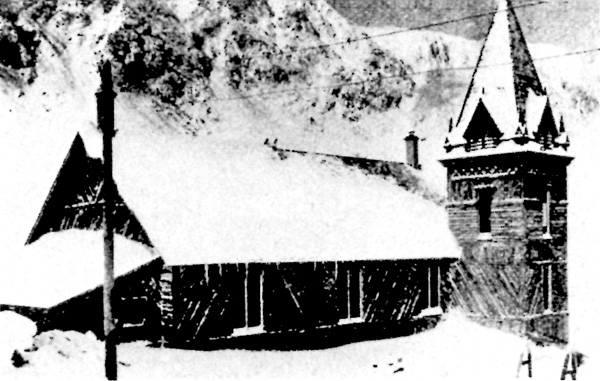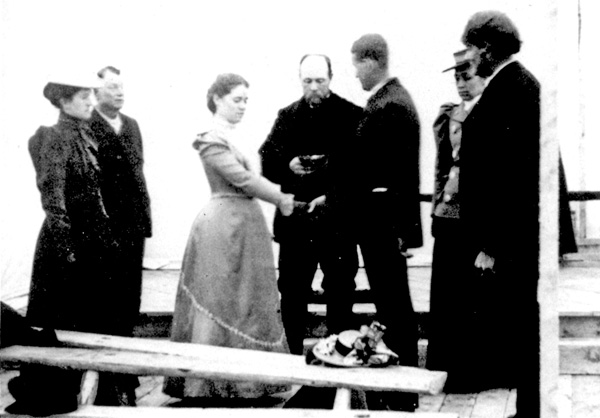|
|
 |
Canadian Historic Sites: Occasional Papers in Archaeology and History No. 26
St. Andrew's Presbyterian Church, Lake Bennett, British Columbia
by Margaret Carter
The Church in Action
Comfortable quarters were still scarce in Bennett in
1899, and it was important they serve as many functions as possible. An
Anglican missionary arrived in Bennett in 1899 and set up headquarters
in a crude tent (Fig. 60), but upon completion of St. Andrew's Church
he held services in the building as well.1 Presbyterian
services were conducted at 2 and 7 on Sunday, and were well attended:
"although the population has decreased by two thirds I had one of the
best congregations yet last Sunday."2 Sunday school classes
were held every week long before the church was completed. Hazel
Hartshorn Gloslie, who was in Bennett as a child, remembers sitting on
crates in the unfinished building to learn her lessons.3
There was an active Ladies Aid Society4 (see Fig. 61). An
evening prayer and praise service was also held in the middle of the
week. Those attending sat on benches that could easily be moved aside,
for church uses extended far beyond the usual worship function.

60 The church.
(Sinclair Papers.)
|

61 One of the postcards printed up and sold
by the Ladies Aid to obtain money for the church.
(Sinclair Papers.)
|
Socials occurred every week, first on Thursday, then on Tuesday.
Their object was "to bring the men into contact with what family life we
have in the town. It is remarkable how an introduction to wives and
daughters make the average man without a family more particular about
his conduct and associates,"5 wrote Sinclair. These socials
were so popular that they attracted as many as 60 people to one
gathering6 — a number which included visitors, church
members as well as other Bennett residents. A description of one of the
socials in the Bennett Sun of 5 August 1899 accounts for their
success, for everyone participated. The program included several solo
and duet renditions of favourite songs, political discourses and comical
elocutions. At a later session, Sinclair himself entertained as a part
of a quartette — "Messrs. Stewart, DuBressy, Cullen and Sinclair!
We sang (1) 'The watch on the Rhine' encore Canadian Boat Song. (2)
'Polly Wolly Doodle All the Day!' Encore 'Trembling O'er us.' What do
you think of your old man in this new role!" 7 he jokingly
wrote his wife.
The church was used as a community centre during the day. Sinclair
reported,
Our pretty, cosy little Church is the most popular rendezvous in
town for the best people. They hold socials, write letters, have
business meetings, meet engagements, read, smoke, file saws (when there
are no ladies present), and sometimes do a little courting in the place,
which in a better equipped town, they would reserve exclusively for
worship. 8
He provided plenty of fuel for the stove, books, and a wide variety
of periodicals sent from the south for reading matter (see Appendix B).
The church also contained paper and pens for writing.
Figure 54 shows that special tables were constructed on the front
sides of the building to hold these materials and act as writing desks.
Sinclair secured a gramophone for those who wanted entertainment and
kept it in good repair while ensuring that those interested had a
variety of music to listen to.9 He encouraged discussion
among the thoughtful. The aim of this activity was to keep men away from
saloons and gambling, and Sinclair was so successful at this campaign
that the gamblers themselves singled him out for blame when their
'dens' were closed in 1900.10
The pastor of Lake Bennett church held his first wedding in the
church while the walls were still of canvas (Fig. 62) and buried many
dead. He sought out the sick and escorted the seriously ill to hospital
in Dawson or Skagway.11 Hospital bills were paid through a
fund collected at the weekly socials. During the winter of 1899 he
repaired the cracks in Grant's old manse.12 Before long,
everyone knew and liked Sinclair; consequently, they felt welcome in the
church.

62 First wedding in St. Andrew's Church tent.
(Sinclair Papers.)
|
Not the least of the reasons the church at Bennett grew as it did by
the spring of 1900 was its success in meeting some very pressing Yukon
needs. On his return from the Klondike in 1899, Bennett's second
minister Dickey pointed out, "a great many of the people have been on
the frontier for many years and look upon a church as altogether
unnecessary. They do not feel the need of a church unless you can show
them that the church is doing some practical good."13 He
continued to list the avenues they considered productive: "caring for
the sick, providing for the destitute, leading intellectual and social
pursuits." This list aligns very well with a detailing of the possible
functions that could be performed by Yukon churches given by G.E.
Gartrell in a thesis on the subject.14 Gartrell outlines
four: ministration of spiritual needs, entertainment, hospital services
and education. As the previous paragraphs indicate, Sinclair developed
all of these aspects extensively while he was in Bennett — with
considerable emphasis on the practical.
Sinclair's ability to understand community needs and take measures to
fulfil them played no small part in the growth of the church. His
autonomy and that of the ministers that preceded him in Bennett was an
integral part of the Presbyterian mission policy. According to Gartrell,
the Presbyterian Church's policy of treating each missionary or "parish"
as a unit which could best determine its own needs15 played a
major role in making it the most successful in the Yukon field.
|

